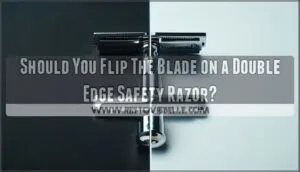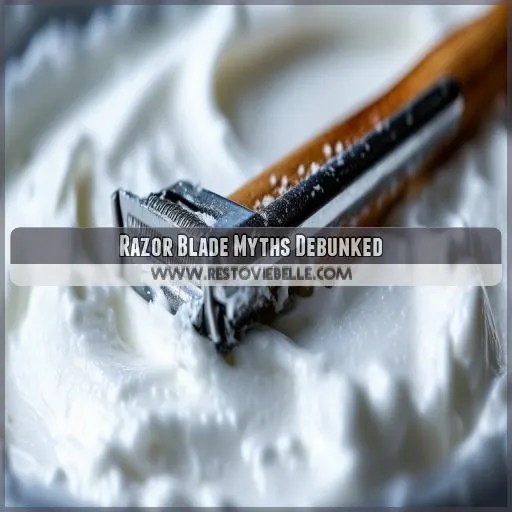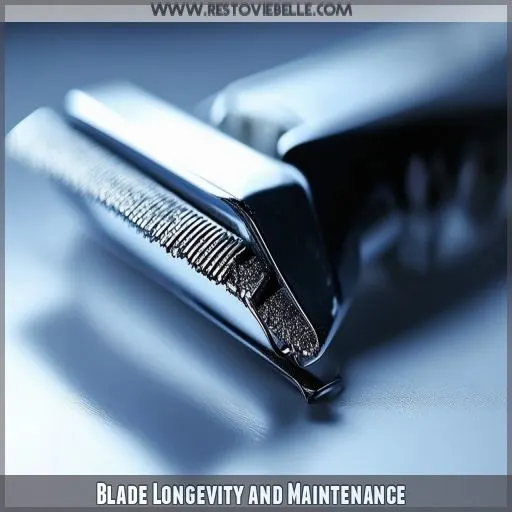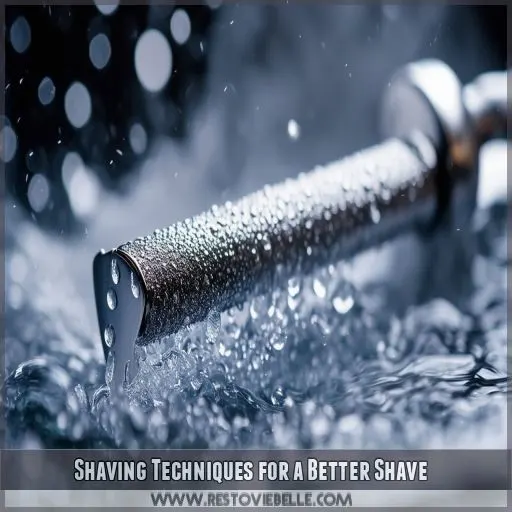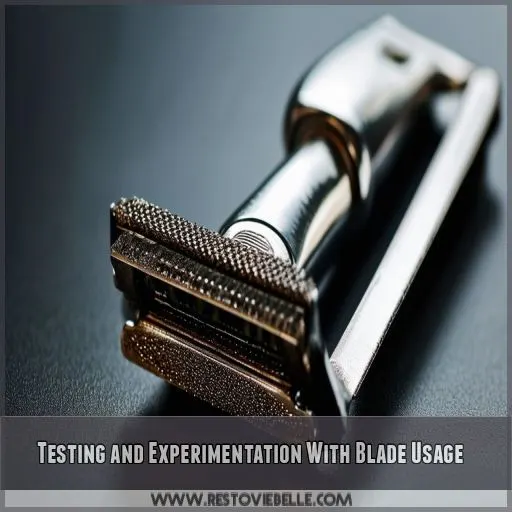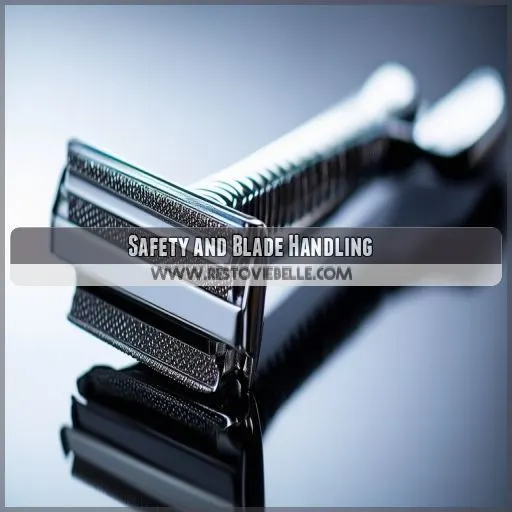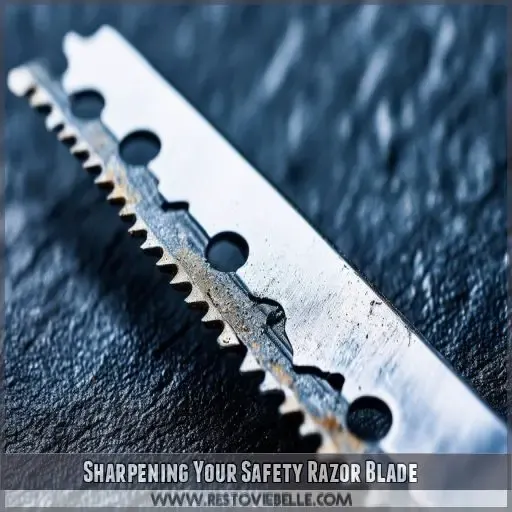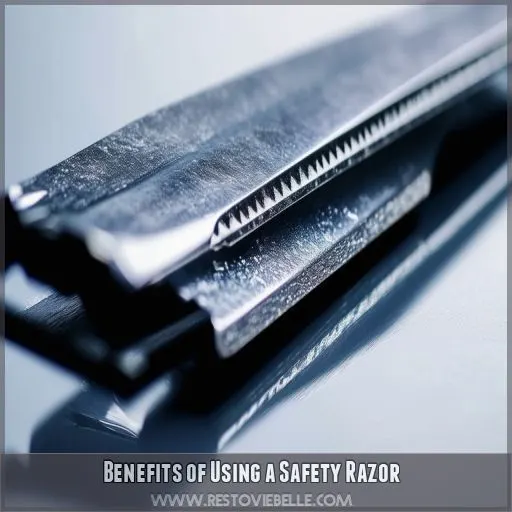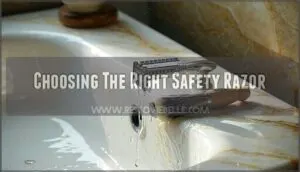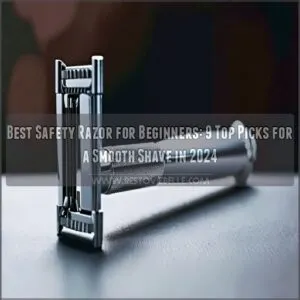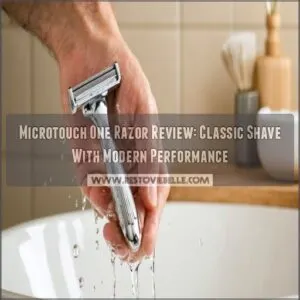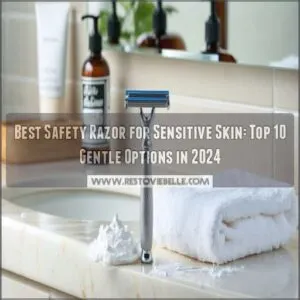This site is supported by our readers. We may earn a commission, at no cost to you, if you purchase through links.
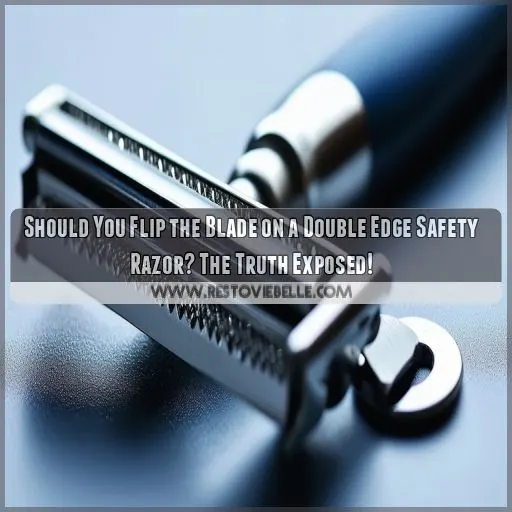
It gives you a smooth, close shave that’s kind to your skin and wallet.
But one question always pops up: should you flip the blade?
You’ve heard tales of sharper edges and longer blade life, but is it true?
Well, let’s cut to the chase and uncover the truth.
Stay sharp and keep reading to discover the do’s and don’ts of flipping that blade.
Table Of Contents
- Key Takeaways
- Should You Flip the Blade on a Double Edge Safety Razor?
- Razor Blade Myths Debunked
- Blade Longevity and Maintenance
- Shaving Techniques for a Better Shave
- Testing and Experimentation With Blade Usage
- Safety and Blade Handling
- Sharpening Your Safety Razor Blade
- Benefits of Using a Safety Razor
- Choosing the Right Safety Razor
- Frequently Asked Questions (FAQs)
- Should you flip the blade on a safety razor?
- Do you use both sides of a double edge razor?
- Which direction should a safety razor be shaved?
- How to put blade in double edge razor?
- What is the best way to store my razor?
- How often should I change my blade?
- How can I prevent razor burn?
- How do I dispose of used blades?
- What is a shaving brush used for?
- Conclusion
Key Takeaways
- Flipping the blade is like trying to teach an old dog new tricks – it won’t magically improve your shave or extend blade life. The edge does all the work, regardless of which side you use.
- If your shave feels rougher than a cat’s tongue, it’s probably time to swap out that dull blade or fine-tune your technique. Don’t blame the flip – focus on the fundamentals!
- Treat your razor like a prized possession. Keep it clean, dry, and stored properly. A well-maintained blade is your ticket to smooth sailing (or should we say, smooth shaving?).
- Experiment with different blades, techniques, and products to find your perfect shave. It’s like finding your soulmate – when you know, you know!
Should You Flip the Blade on a Double Edge Safety Razor?
You might’ve heard whispers about flipping the blade on your double edge safety razor, but here’s the scoop: it’s not necessary.
Both sides of the blade are equally sharp and ready to tackle your stubble. The edge is what does the heavy lifting, not a specific side.
So, don’t waste time playing flip-the-blade when you could be perfecting your technique. Focus on proper prep, lathering up like a pro, and maintaining your blade instead.
If your shave isn’t smooth sailing, it’s probably due to a dull blade or wonky technique.
Stick around, and we’ll sharpen your shaving skills to give those pesky myths a close shave.
Razor Blade Myths Debunked
Let’s get straight to the point and address some common misconceptions about razor blades. You’ve probably heard the age-old debate about whether you should flip the blade on a double-edge safety razor. Well, it’s time to set the record straight and separate the facts from the fiction.
No Top or Bottom to a Razor Blade
There’s a common razor blade myth that you need to pay attention to the orientation of your blade, with a "top" and "bottom" side.
The truth is, there’s no need to worry about which way your blade faces. The edge does the shaving, not a specific side.
Flipping it won’t magically improve your shave, and a poor shave is more likely due to a dull blade or your technique.
Edge is What Shaves, Not a Specific Side
There’s a common misconception that you need to stick to one side of a double-edge safety razor blade for the best results.
But here’s the truth: it’s the edge that does the shaving, not a particular side.
Flipping the blade won’t magically improve your shave.
If you’re experiencing a poor shave, it’s more likely due to a dull blade or your technique.
Flipping the Blade Won’t Improve Your Shave
You might’ve heard the old wives’ tale that flipping your razor blade will give you a closer shave. But sorry to burst your bubble, it’s a myth! The truth is, flipping the blade on your double-edge safety razor isn’t going to magically transform your shaving experience. Here’s why…
First off, it’s all about the edge. The sharp edge of the blade does the heavy lifting, not a particular side. So, whether you flip it or not, you’re still working with the same edge. Think of it like a sword – it doesn’t matter which side you hold it from, the blade will cut just the same.
Now, some folks might swear by this technique, claiming it gives them a smoother shave. But the reality is, if you’re not getting a close shave, it’s likely due to a dull blade or your technique needing some fine-tuning. So, instead of flipping the blade, try swapping it out for a fresh one or focus on mastering that shaving technique.
Poor Shave Due to Dull Blade or Incorrect Technique
So, you’re getting a poor shave and wondering if it’s your blade or your technique. Let’s get to the bottom of this.
First off, a dull blade is a common culprit. If your blade is tugging at your skin or hair, it’s a sure sign it’s time for a change. But don’t forget, your shaving technique matters too. Make sure you’re holding your razor at a shallow angle and using shaving cream or soap to lubricate. A week-old beard can be tricky to tackle, so give your facial hair a good soak with hot water to soften it up.
Now you’ve got the lowdown on dull blades and shaving techniques. Time to get that smooth, close shave you deserve!
Blade Longevity and Maintenance
Not all razor blades are created equal – some last longer than others. But does flipping your blade really make a difference?
Some Blades Last Longer Than Others
Blade longevity isn’t a one-size-fits-all thing. Some blades last longer than others, and that’s just a fact of life. But why is that? Well, it’s a combination of factors, including:
- Blade Quality: Some blades are simply made with higher-quality materials and craftsmanship, leading to a longer-lasting edge.
- Usage and Maintenance: How often you shave and how well you take care of your blade can impact its lifespan. Proper storage and handling can extend its life.
- Beard Texture: If you have a coarser, thicker beard, you might find that blades dull faster. It’s not your imagination—it’s the reality of shaving tougher hair.
Burr Affects Both Sides of the Blade Equally
The Truth About Blade Longevity and Maintenance
You might be wondering if flipping your double-edge safety razor blade will give you a better shave. Well, the truth is, a burr affects both sides of the blade equally. So, whether you flip it or not, the burr will have the same impact on your shave.
Here’s a quick breakdown of the facts:
| Fact | Explanation |
|---|---|
| Burrs Don’t Discriminate | A burr is a tiny bend or deformation along the blade’s edge. It can happen on either side, but it affects both sides equally. |
| Equal Opportunity Shaving | Whether you’re shaving with the top or bottom side of the blade, the burr will impact the performance in the same way. |
| Blade Longevity | Flipping the blade won’t make it last longer. The burr is a sign that your blade needs to be replaced. |
| Maintenance Matters | Proper maintenance, including cleaning and storage, can help extend the life of your blades and reduce the occurrence of burrs. |
Shaving Techniques for a Better Shave
Whether you’re a seasoned shaver or a newbie, nailing the perfect shave is an art. We’ll walk you through the ins and outs of shaving techniques, from softening that stubble to gliding your razor like a pro.
A Week-Old Beard is Harder to Shave
You’ve let your facial hair run wild for a week. Now it’s time to tame that beast. A week-old beard is a challenge to shave, no doubt. But don’t worry, we’ve got some tips for you. First, grab your razor and get ready to tackle that growth.
Soaking Your Beard With Hot Water Softens the Hair
Let’s talk about softening that stubble. Soaking your beard with hot water is a simple yet effective way to prep your facial hair for shaving. Think of it like this: hot water is nature’s hair conditioner. It softens and relaxes those coarse beard hairs, making them easier to cut and reducing the risk of tugging and irritation.
Use Shaving Cream or Soap to Lubricate Your Skin
Whether you’re a shaving novice or a grizzled veteran, there’s no denying that a smooth, irritation-free shave is the ultimate goal. So, let’s talk about how to get there.
The Lubrication Station
When it comes to shaving, lubrication is key to achieving a close, comfortable shave. Here’s why:
- Creating a Slip ‘n’ Slide for Your Razor: Shaving cream or soap creates a slick surface, allowing your razor to glide effortlessly across your skin. No more tugging or pulling!
- Hydration Station: These products are designed to hydrate your skin and hair, making it easier for the razor to cut through those pesky whiskers.
- Protection from Irritation: The right lubrication can act as a barrier between your skin and the razor, reducing the chances of razor burn and other irritation.
- The Perfect Canvas: By creating a rich, creamy lather, you’ll be able to see where you’ve shaved and where you haven’t, ensuring an even shave every time.
So, which should you choose: shaving cream or soap? Well, my friend, that’s a matter of personal preference. Some folks prefer the traditional, rich lather of shaving soap, while others opt for the convenience of shaving cream. The key is to experiment and find what works best for your skin and shaving routine.
Now you’re armed with the knowledge to lubricate and navigate your way to a better shave.
Testing and Experimentation With Blade Usage
Getting the most out of your safety razor blades can be a bit of a trial and error process. There’s no magic formula, but finding what works best for you is part of the fun of wet shaving. Here are some tips to get you started:
- Flip After Each Shave: Some folks swear by this method. By flipping the blade after each use, you’re giving each side a break, which can help extend the blade’s overall life.
- Weekly Flip: Another approach is to use one side of the blade for a week and then flip it over for the next week. This way, you’re giving each side an equal amount of use and potentially doubling the blade’s lifespan.
- Mix and Match: Don’t be afraid to experiment. Try using one side of the blade for a few shaves and then flipping it to see if you notice any differences. You might be surprised by the results and find your ideal setup.
Safety and Blade Handling
Let’s talk about safety and handling those sharp blades. You don’t want to end up with nicks and cuts, or worse, a damaged razor. So, it’s time to get savvy about proper blade care and keeping your fingers intact.
Removing and Reinserting Injector Blades Can Damage the Edge
Let’s address a common concern: removing and reinserting blades. This practice can damage the edge of your injector blades, reducing their sharpness and effectiveness. It’s like trying to put a genie back in the bottle—it’s tricky business!
| Blade Handling | Consequence |
|---|---|
| Removing & Reinserting Blades | Edge Damage |
| Improper Handling | Injury Risk |
| Blade Sharpening | Maintains Sharpness |
| Proper Disposal | Safety & Hygiene |
Handle Blades Carefully to Avoid Injury
Safety is your number one priority when handling blades.
These bad boys are sharp, and one wrong move can lead to a nasty cut. You don’t want to be sporting a bandaid on your face, do you?
So, take your time and be extra cautious when removing or inserting blades. It’s a delicate operation.
Always follow the manufacturer’s instructions for your razor, and if you’re not sure, take a moment to look it up.
It’s better to be safe than sorry, my friend.
Use a Blade Sharpener to Maintain the Edge
Now, let’s talk about keeping that blade in tip-top shape. You’ve likely heard the saying, "a dull blade is a dangerous blade." Well, it’s true! A dull blade can lead to nicks, cuts, and an uncomfortable shave. So, what’s the solution?
Enter the blade sharpener. This handy tool will help you maintain the edge of your blade, ensuring it stays sharp and effective. It’s like giving your blade a little tune-up to keep it performing at its best.
But, be warned: sharpening a blade is a delicate task that requires precision and patience. It’s not a quick fix, but a careful process that, when done right, can extend the life of your blade and improve your shaving experience.
Dispose of Used Blades Properly
Don’t just toss used blades in the trash. Here’s a friendly reminder to handle and dispose of those sharp little suckers safely. You don’t want to be fishing a blade out of the bin or, worse, end up with a trip to the ER.
Here are some quick tips to keep yourself and others safe:
- Don’t throw loose blades in the trash.
- Do wrap used blades in paper or cardboard before tossing them.
- Don’t put blades down the drain.
- Do recycle blades if your area offers blade recycling.
- Do invest in a blade bank or blade disposal container.
Sharpening Your Safety Razor Blade
So, you’re wondering if flipping the blade on your double-edge safety razor is the answer to a smoother shave. Well, my friend, it’s time to sharpen those blades and extend their lifespan!
Let’s explore sharpening safety razor blades and uncover the secrets to a closer, more comfortable shave.
Why Sharpen Your Safety Razor Blade?
Sharpening your safety razor blade is a game-changer for several reasons:
- Blade Longevity: Sharpening triples the lifespan of your double-edge razor blades, saving you money and reducing waste.
- Cost Savings: By extending blade life, you spend less on replacements, making it easier on your wallet.
- Eco-Friendly: Reducing blade waste is a greener approach, helping you lower your environmental impact.
- Improved Shave: A sharp blade provides a closer, more comfortable shave, reducing razor burn and skin irritation.
- Healthier Skin: Say goodbye to razor burn and hello to smooth, irritation-free skin.
When to Sharpen Your Safety Razor Blade
So, when should you sharpen your safety razor blade? Well, there are a few tell-tale signs that it’s time to give your blade some TLC:
- You notice a definite dullness or tugging sensation when you shave.
- You’re spending way more time shaving because you have to go over the same area multiple times.
- Your skin isn’t happy – we’re talking razor burn and irritation.
- Your blade is pulling at your hair instead of cutting it cleanly.
- You’re left with an uneven shave and patches of hair.
Tools You Need to Sharpen Your Blade
Now that you know when to sharpen your blade, let’s get into the tools you’ll need to get the job done right. Here’s a checklist to make sure you’re prepared:
- Honing Pad: A leather honing pad is key. It’s the canvas for your sharpening symphony.
- Safety Razor: Your trusty tool, but make sure the blade is securely fastened. You don’t want any slip-ups.
- Clean Surface: A neat workspace is a safe workspace. Keep it tidy for good results.
- Water (Optional): H2O, the liquid of life, can be used to dampen the pad, but it’s your call.
- Patience: This isn’t a race. Take your time, and you’ll master the art of sharpening.
Sharpening Steps and Tips
Now that you’ve gathered your tools, it’s time to get started with sharpening. Don’t worry, it’s not as scary as it seems. Here’s a simple step-by-step guide:
| Step | Instruction | Tip |
|---|---|---|
| 1 | Secure the Blade | Make sure it’s tight. |
| 2 | Position the Razor | Place at the bottom of the pad, tilted at a 35-degree angle. |
| 3 | Sharpening Stroke | Push up, lift, and return. |
| 4 | Repeat | Up to 5 times. |
| 5 | Flip and Repeat | Flip 180 degrees and repeat steps 2-4. |
Benefits of Using a Safety Razor
If you’re wondering whether to flip the blade on your double-edge safety razor, you’re not alone. Many folks question if this technique improves their shave. But beyond this specific query, let’s explore the broader benefits of using a safety razor.
You might be surprised to discover the advantages a safety razor offers over modern cartridge razors. From cost savings to a more personalized shaving experience, get ready to see the perks of this classic shaving tool.
Lower Long-Term Costs
Using a safety razor can save you serious cash over time. The initial investment in a quality safety razor may be higher, but the blades are where the real savings kick in. They’re a fraction of the cost of multi-blade cartridges and last longer.
You’re in control of your spending, swapping blades only when needed. No more overpriced cartridge refills that feel like a rip-off. Now that’s a welcome change!
More Choice Over Your Shave
Using a double-edge safety razor gives you more choice and control over your shaving experience. Here’s how:
- Choice of blades: You can experiment with different blades to find your perfect match. Some blades last longer, while others offer a closer shave. It’s all about personal preference and finding what works best for your skin and beard.
- Shaving frequency: With a safety razor, you’re not locked into a specific shave frequency. You can choose to shave daily, every other day, or even less frequently. This freedom lets you adjust your shaving routine to your lifestyle and beard growth.
- Shaving techniques: The safety razor allows you to explore different shaving techniques. You can try varying the angle of the razor, using different types of shaving creams or soaps, and even experimenting with pre-shave and post-shave routines to enhance your overall experience.
- Customizable experience: Safety razors offer a wide range of customizable options. You can choose the type of razor, blade brand, shaving brush, and shaving soap or cream that suit your unique needs. This level of customization makes sure your shaving routine is suited to your skin and preferences.
More Control Over Your Shave
You’re the captain of your shave with a safety razor.
No more wrestling with multi-blade cartridges that bulldoze your skin.
With a safety razor, you call the shots. Angle it just so, and it slices through stubble like butter.
Too steep, and you’ll nick yourself – a lesson you’ll learn fast.
But once you nail it, you’ll master the sweet spot for a shave that’s smooth, close, and irritation-free.
It’s all about control, baby.
Less Irritation
Safety razors offer a closer, more comfortable shave with less irritation. Here’s why:
- A safety razor’s design helps prevent razor burn and skin irritation.
- The single blade cuts hair at skin level, reducing the risk of ingrown hairs and bumps.
- You can experiment with different blades to find the perfect match for your skin, giving you a personalized, irritation-free shave.
- The weight and handle length of safety razors provide a controlled, precise shave, minimizing skin irritation.
Better for the Environment
| Disposable Razors | Safety Razors | |
|---|---|---|
| Waste Reduction | Clogs landfills with plastic waste | Reusable metal blades reduce waste |
| Cost-Effectiveness | Expensive cartridge replacements | Affordable, long-lasting blades |
| Eco-Friendliness | Harmful to the environment | Eco-friendly, less waste |
| Self-Care | Inconvenient, costly | Easy on your wallet and the planet |
| Sustainable Shaving | Unsustainable, wasteful | Sustainable, reusable blades |
Choosing the Right Safety Razor
Choosing the right safety razor is a big deal. You want a smooth, close shave without irritation, and the right razor makes all the difference.
Let’s break down the key features to look for so you can pick the perfect safety razor for your shaving needs.
Razor Construction
When choosing a safety razor, the design and construction of the razor are really important to your shaving experience. Here are some key things to think about:
- Design and Construction: Look for a razor that’s well-made with a solid design. A sturdy build will help you get a smooth, close shave.
- Blade Exposure: How much of the blade is visible when the razor is closed varies from razor to razor. Some offer more aggressive exposure for a closer shave, while others provide milder exposure for added safety. Choose based on your comfort level and shaving technique.
- Handle Length and Grip: The handle length and grip affect how much control you have while shaving. Opt for a longer handle if you prefer a more traditional grip, or a shorter handle for a closer, more precise grip. Make sure the handle provides a secure grip to prevent slipping during use.
- Weight: The weight of the razor affects the shaving experience. Heavier razors provide more weight behind the blade, resulting in a closer shave with less pressure needed. Lighter razors offer more control and precision but may require slightly more pressure. Choose a weight that suits your shaving style and comfort level.
Skin Guard Design
When choosing a safety razor, the skin guard design matters. This small part plays a big role in your shaving experience, so it’s worth paying attention to.
The skin guard, or blade guard, is the metal bar that sits between the blade and your skin. Its job is to stretch your skin, giving the blade a smoother surface to glide over.
Different razors offer different guard designs. Some are straight, some are curved, and some have a comb-like design. Each design has its own benefits and drawbacks, so it’s important to choose one that suits your skin and shaving needs.
A straight guard offers a classic, no-frills approach. It gives you a close shave but may not be as gentle on sensitive skin. Curved guards are designed to follow the contours of your face, offering a more comfortable shave. Comb guards are less common but provide extra protection by guiding the hair into the path of the blade.
The key is to find a guard design that gives you the right balance between closeness and comfort. It’s a bit of a Goldilocks situation – you might need to try a few razors to find the one that’s "just right" for your skin.
Shaving Efficiency
Shaving efficiency is key to a smooth, irritation-free experience. Choosing the right safety razor can make all the difference. Opt for a razor with a pivoting head that adjusts to your skin’s contours. This dynamic flexibility helps you get a close shave without the nicks and cuts.
Look for a razor with an anti-clog design, too. This feature prevents hair buildup, keeping your blades sharp and your shave seamless. A quick rinse is all it takes to keep your razor in top form.
Weight and Handle Length
When choosing a safety razor, weight and handle length are key factors that influence your grip and overall feel of the razor. Here’s what you need to know:
- Weight: A heavier razor provides a more solid, sturdy feel, giving you better control during your shave.
- Handle Length: Opt for a longer handle if you prefer a comfortable, easy grip. A shorter handle allows for more maneuverability and precision.
- Balance: Go for a balanced weight distribution to prevent the razor head from feeling too heavy or light.
- Personal Preference: Ultimately, the right weight and handle length come down to what feels comfortable in your hand and gives you the control you need for a close shave.
Specialty Variations
Let’s talk about the different types of safety razors out there. You might be surprised to learn that there are some cool variations that can really change how you shave.
Some safety razors have special features that make them stand out from the basic models. Here are a few of them:
- Adjustable razors: These let you change how much of the blade is exposed and the angle of the blade to get the perfect shave for your skin and beard.
- Slant bar razors: These razors have a slanted blade that cuts through hair like a hot knife through butter. Okay, maybe not butter, but you get the idea.
- Open comb razors: These are like regular safety razors, but they’ve a comb-like guard that lifts your whiskers for a closer shave.
Frequently Asked Questions (FAQs)
Should you flip the blade on a safety razor?
There’s no need to flip the blade. The edge does the shaving, not a specific side. Flipping won’t improve your shave, and it might even damage the blade.
Do you use both sides of a double edge razor?
You can use both sides of a double-edge razor, but there’s no consensus on whether flipping the blade improves your shave. Some swear by flipping after each shave, while others stick to one side for a week. Experiment to find what works for you.
Which direction should a safety razor be shaved?
It’s up to you, but most folks shave in the direction of hair growth first, then go against the grain for a closer shave. Always be gentle to avoid irritation and razor burn.
How to put blade in double edge razor?
Grip that razor like you’re holding a magic wand and get ready to cast a smooth shave spell.
First, unscrew the razor’s head and pop out the old blade. Then, carefully slide in the new blade, making sure it’s snug and secure. Screw the head back on, and you’re ready to rock and roll.
What is the best way to store my razor?
Keep your razor in a dry place. Store it outside the bathroom, away from steam and moisture. You can also coat the blade in oil to prevent rust.
How often should I change my blade?
Aim to swap out your blade after 5-7 shaves. This keeps your shave smooth and helps prevent irritation.
How can I prevent razor burn?
Think of your skin as a delicate canvas and your razor as an artist’s brush. To avoid the fiery fury of razor burn: hold your razor at a shallow angle, use shaving cream, and swap out your blade regularly.
How do I dispose of used blades?
Used blades are sharp, so wrap them in thick paper or tape before tossing them in the trash. Better yet, recycle them at a local collection point. Keep yourself and others safe!
What is a shaving brush used for?
A shaving brush is used to create a rich, thick lather that softens your skin and facial hair. This lather acts as a lubricant, allowing your razor to glide smoothly across your skin for a closer, more comfortable shave.
Conclusion
Flipping the blade on your double-edge safety razor is a bit like trying to squeeze orange juice from an apple—it’s just not going to give you the results you want.
While it might seem like a quick fix for a dull blade, it won’t improve your shave.
The truth is, both sides of the blade wear down equally, so flipping it won’t give you a sharper edge or a closer shave.
Instead, focus on finding the right blade for your razor, mastering the art of shaving technique, and keeping your blade sharp and well-maintained.

